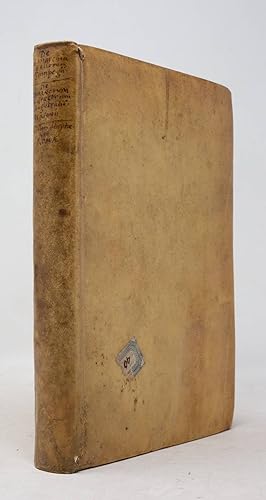symphorien champier joachim périon césar (1 Ergebnisse)
Produktart
- Alle Produktarten
- Bücher (1)
- Magazine & Zeitschriften
- Comics
- Noten
- Kunst, Grafik & Poster
- Fotografien
- Karten
-
Manuskripte &
Papierantiquitäten
Zustand
- Alle
- Neu
- Antiquarisch/Gebraucht
Einband
- alle Einbände
- Hardcover
- Softcover
Weitere Eigenschaften
- Erstausgabe
- Signiert
- Schutzumschlag
- Angebotsfoto
- Kein Print-on-Demand
Land des Verkäufers
Verkäuferbewertung
-
A Sammelband: The Sack of Rome in its historical context -- De Monarchia Gallorum campi aurei. . . -- De Monarchia ac Triplici Imperio. . . -- Romanorum et Græcorum magistratibus libri tres. . . -- Historia Expugnatæ et direptæ urbis Romæ per exercitum Caroli V. Imp. . .
Verlag: Melchior and Gaspard Trechsel et al., Lyon, 1537
Anbieter: Arader Books, New York, NY, USA
Erstausgabe
Hardcover. Zustand: Very good. First. FROM THE DISTINGUISHED LIBRARY OF THE FRÈRES SAINTE-MARTHE. Quarto (8 ¾" x 6 5/16", 220mm x 160mm). [Full collation available.] Bound in XVIIc stab-bound vellum over boards. Titles and authors ink manuscript to spine. Some darkening to the spine. Shelf-label affixed to the front cover (partially obliterated). Printer's device and lower-edge of the title-page of no. 2 (A1) excised and restored. Marginal damp-stain to the margins of the first two works. A little tanning, and very occasional mild foxing. Ownership signatures of Louis and Scévole de Sainte-Marthe (known as the frères Sainte-Marthe) -- "De Sainte Marthe" flanking the printer's device, "Ex Bibliotheca Fratrum Sammarthanorum" at the lower edge -- of the title-page of nos. 1 and 4 (and doubtless excised from no. 2). Engraved armorial bookplate of Sainte-Marthe to the front paste-down. The sack of Rome, initiated on 6 May 1527, was one of the most consequential events in modern European history. The army of Charles V, Holy Roman Emperor (a Catholic), had a great many Lutheran soldiers. Charles had run short of funds, and the unpaid soldiers mutinied and formed a detachment under the Duke of Bourbon, forcing him to lead them to the walls of Rome and to pursue the heart of the Catholic Church. For a month they ransacked and pillaged the city till at last Pope Clement VII -- born Giulio de' Medici -- surrendered, succumbing to a great many of the demands of Charles, who disavowed any role in the sack. The consolidation of power in a single figure, ruling over more of Europe than any man since the fall of the Western Roman Empire in 476, signalled a new phase in the European Renaissance. Gathering together four works written over 100 years (the earliest just ten years after the sack), the volume explains the "triplex imperium" -- the tripartite Holy Roman Empire, comprising the Roman, French (Frankish) and German territories -- that was flourishing in the XVIc and XVIIc. Symphorien Champier (1471-1539) is best known as a medical writer, but in his later years he wrote nationalist accounts of the role of France vis à vis the Holy Roman Empire. Joachim Périon (1499-1559) was a French humanist who "de-medievalized" classical texts, and was one of the pivotal philologists of the Renaissance. Published the year after his death, this study of the magistracies of Greece and Rome was edited by his nephew François, having been found among his papers. The treatise was dedicated to Odet de Coligny, known as the Cardinal de Châtillon, but the epistle dedicatory is addressed to Scévole de Sainte-Marthe. This is the father (1536-1623) of the owners of the Sammelband: a distinguished poet, humanist and financier to Henry III and IV. Was this the copy of the dedicatee, inherited by his sons? César Grolier (ca. 1510-ca. 1595) was the son of the incomparable bibliophile Jean Grolier, and went to make his name in the Roman Curia. Only 17, César witnessed first-hand the destruction of Rome, and, his father's son, lamented the damage done to the Vatican library in particular. The work --published here for the first time, 110 years after its authorship -- is in the form of a letter to his father. It is intensely vivid and personal, although its Latinity is perhaps indicative of his tender age. Louis (1571-1656) and Scévole (II, 1571-1650) were twin brothers. Humanists, poets, historians, they were named jointly as historians to the king. From 1626 to their deaths they worked on the massive Gallia Christiana, cataloguing the dioceses, abbeys and personnel of the church in France from the introduction of Christianity; the volumes began to appear in 1715, and the project was not completed until well into the XIXc. The works collected (doubtless by the Sammarthani, as the ink ownership inscription to item 4 has offset onto the final leaf of item 3) must have been of great use in the preparation of this massive work. Brunet, I.1769 (Champier), II.1761 (Grolier).


